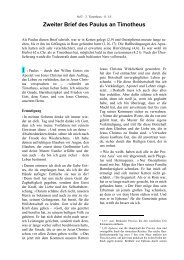You also want an ePaper? Increase the reach of your titles
YUMPU automatically turns print PDFs into web optimized ePapers that Google loves.
The brain<br />
– the most complex structure<br />
in the universe<br />
“For thousands of years people have tried to<br />
understand the brain. The ancient Greeks thought<br />
it was like a radiator to cool the blood. In this<br />
century it has been compared to a switchboard,<br />
a computer, and a hologram – and no doubt it<br />
will be likened to any number of machines yet to<br />
be invented. But none of these analogues is adequate,<br />
for the brain is unique in the universe<br />
and unlike anything men have ever made.”<br />
(Robert Ornstein / Richard F Thompson: The<br />
Amazing Brain. Houghton Miffin Company,<br />
Boston, 1984)<br />
The human brain, located inside our skull and<br />
weighing about 1.5 kg, is described by professors<br />
Robert Ornstein (University of California) and<br />
Richard F. Thompson (Stanford University) in the<br />
above words. It can rightly be called the most<br />
complex physical structure in the universe.<br />
The brain is the central controlling organ of our<br />
nervous system. It controls, watches over, and<br />
coordinates nearly all the processes occurring in<br />
the body. It collects, evaluates and stores sensory<br />
impressions, and effects meaningful responses.<br />
Practically nothing is known about the way<br />
information processing actually takes place in<br />
the brain. Nobody knows how the perceived<br />
semantic information is derived from the incoming<br />
electrical signals. We do know that certain<br />
activities originate in the cerebral cortex (the<br />
outer layer of the cerebrum), and we also know<br />
that certain memories are stored there. But we<br />
do not know how they are stored, nor how we<br />
recall specific memories. We also do not know<br />
how novel ideas originate, nor what happens in<br />
the brain when something new is learnt. The little<br />
we do know about the functions of various parts<br />
of the brain has essentially been obtained by<br />
observing the changes resulting from brain damage<br />
or tumours. The only real knowledge we have<br />
of the brain is on the statistical level, like the<br />
number of structural elements and the estimated<br />
number of interconnections. Even this statistical<br />
information highlights the astounding properties<br />
of the most complex structure in the universe.<br />
The number of structural units: The brain comprises<br />
about one hundred thousand million nerve<br />
cells (100 x 10 9 ). The term “neurons” coined by<br />
W. von Waldeyer in 1891, is used as a synonym<br />
for nerve cells. They are the structural elements<br />
of the brain, and their number is of the same<br />
magnitude as the number of stars in our local<br />
galaxy. No two of them have exactly the same<br />
shape. In addition to this immense number of<br />
neurons, there are also one hundred thousand<br />
million other cells, providing metabolic functions<br />
and structural support.<br />
Every neuron is connected to thousands of others<br />
by means of synapses (Greek synapsis = connection).<br />
Even though each nerve cell is not in<br />
direct contact with every other one, it is indirectly<br />
linked with all others via intermediate connections.<br />
It follows that the number of possible<br />
pathways linking the nerve cells in every human<br />
brain is extremly large: 5 x 10 21 (= 5,000 million<br />
million million). It would require 40 printed pages<br />
simply to list the number of direct connections of<br />
a single neuron. In order to list all direct neuronal<br />
links, 40 pages times the number of neurons =<br />
4000 x 10 9 pages, would be required.<br />
Assuming that one book comprises 400 pages,<br />
the required number of books would be 4000 x<br />
10 9 / 400 = 10 x 10 9 . This result is breathtakingly<br />
large. Such a list would require a library containing<br />
ten thousand million books of 400 pages. The<br />
largest library in the world, namely the Library of<br />
Congress in Washington, contains about 20 million<br />
volumes. This means that we would require<br />
500 such libraries just to list the direct connections<br />
in the human brain!<br />
The number of synapses is thus appreciably<br />
greater than the number of neurons. One neuron<br />
receives information from several hundreds, up<br />
to thousands, of other neurons, and transmits it<br />
to a similar number of other nerve cells.<br />
81
















